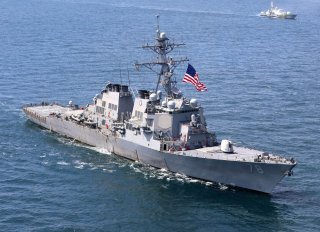A U.S. Navy Arleigh Burke-Class Destroyer Passed Through the Taiwan Strait
The U.S. guided-missile destroyer USS Mustin (DDG-89) certainly lived up to its motto Tourours L’Audace (“Always Be Bold”) this week. After completing an exercise with the Japanese Maritime Self Defense Forces, the warship transited the Taiwan Strait and it certainly attracted the notice of both Beijing and Taipei, each of which deployed warships to monitor the transit.
The U.S. guided-missile destroyer USS Mustin (DDG-89) certainly lived up to its motto Tourours L’Audace (“Always Be Bold”) this week. After completing an exercise with the Japanese Maritime Self Defense Forces, the warship transited the Taiwan Strait and it certainly attracted the notice of both Beijing and Taipei, each of which deployed warships to monitor the transit.
The Arleigh Burke-class destroyer was operating as part of the Ronald Reagan Carrier Strike Group while the USS Ronald Reagan (CVN-76) continued its operations in the South China Sea. The carrier, along with Carrier Air Wing (CVW) 5, USS Antietam (CG 54), USS Mustin (DDG 89) and USS Rafael Peralta (DDG 115), entered the region on August 14 and conducted maritime air defense operations earlier this week.
The U.S. Seventh Fleet’s press office said that the Mustin conducted the routine transit from the East China Sea to the South China Sea in accordance with international law. U.S. Navy warships regularly transit the strait and there have been ten such transits made through the straits this year. This latest transit was meant to demonstrate the United States’ commitment to a free and open Indo-Pacific, and it came just days after the U.S. warship conducted integrated helicopter operations, multi-domain tactical training and communication and formation drills with the Japanese Maritime Defense Force’s Akizuki-class guided-missile destroyer JS Suzutsuki (DD-117) in the East China Sea.
In June, the Navy’s destroyer USS Russell (DDG-59) made the transit shortly after China’s second aircraft carrier left for its sea trials.
Taiwan’s Defense Ministry confirmed the passage of the Mustin through the straits.
“The military is aware of and closely monitors all activities in the sea and air near the Taiwan Strait through the combined intelligence it has gathered,” the Defense Ministry in Taipei said in a statement as reported by the South China Morning Post.
The U.S. Navy’s Arleigh Burke-class guided missile destroyers (DDGs) are built around the Aegis Combat System and were designed as multi-mission destroyers able to fulfill a strategic land strike role with Tomahawk missiles. They can also operate in an anti-aircraft warfare (AAE) role with its powerful Aegis radar and surface-to-air missiles (SAM) and an anti-surface warfare (AsUW) with its Harpoon missile launcher. Finally, these ships can even engage in an anti-submarine warfare (ASW) role with its towed sonar array, anti-submarine rockets and ASW helicopters. The destroyers are around 500 feet long and displace around 9,000 tons.
The Chinese People’s Liberation Army Navy (PLAN) claimed in May that it had expelled the USS Mustin from China’s territorial waters, when the warship passed within twelve nautical miles of Woody Island and Pyramid Rock in the Parcel Islands, an archipelago made up of about 130 small coral islands and reefs. The islands are claimed by several countries, including the People’s Republic of China and Vietnam.
USS Mustin, which has its homeport in Yokosuka, Japan, was launched in December 2001 and commissioned in July 2003. The warship is named after Captain Henry C. Mustin (1874-1923), who is often referred to as the “Father of Naval Aviation” as he was the principal architect in the development of the catapult launch.
The warship is on permanent assignment with the U.S. Seventh Fleet, the largest of the U.S. Navy’s numbered fleets. The Seventh Fleet conducts forward-deployed naval operations in support of U.S. national interests in the Indo-Pacific area of operations. It routinely interacts with thirty-five other maritime nations to build partnerships that are meant to foster maritime security, promote stability and prevent conflict.
Peter Suciu is a Michigan-based writer who has contributed to more than four dozen magazines, newspapers and websites. He is the author of several books on military headgear including A Gallery of Military Headdress, which is available on Amazon.com.
Image: Reuters

